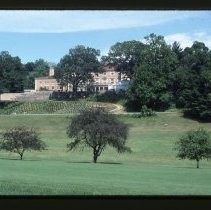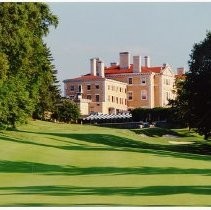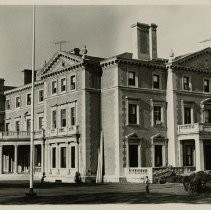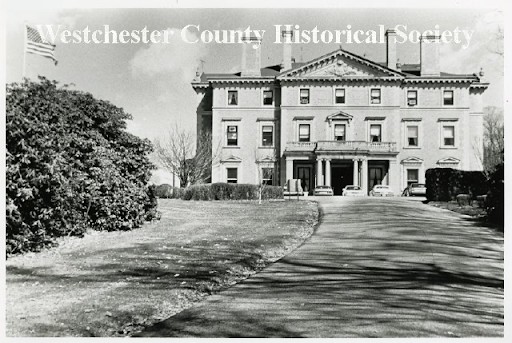Sleepy Hollow Country Club
Introduction
Text-to-speech Audio
The Sleepy Hollow Country Club is located on 200+ acres of scenic Hudson River-adjacent property in the Village of Briarcliff Manor in Westchester County, NY. Included in the Scarborough Historic District, which was listed on the National Register of Historic Places in 1984, the complex comprises a number of historically significant buildings. The clubhouse, formerly the main residence of the “Woodlea” estate of Elliott Fitch Shepard and Margaret Vanderbilt Shepard, was designed in the Renaissance Revival style in the 1890s by the firm of McKim, Mead, and White. Purchased in 1910 by Frank A. Vanderlip (vice president of First National Bank), the following year it was sold to a consortium of wealthy individuals who converted the property and grounds into the Sleepy Hollow Country Club, which continues to own and run it as of 2022.
Images
Sleepy Hollow Country Club

Sleepy Hollow Country Club

Sleepy Hollow Country Club

Sleepy Hollow Country Club

Backstory and Context
Text-to-speech Audio
Elliott Fitch Shepard (1833-1893) was a New York lawyer who had founded the New York State Bar Association in 1876 and later owned the New York newspaper, the Mail and Express. In 1892, Shepard and his wife, Margaret Vanderbilt Shepard (1845-1924), the granddaughter of Cornelius Vanderbilt, purchased “Woodlea,” a country estate of 500+ acres in Scarborough, NY, approximately 30 miles north of New York City, from J. Butler Wright. The following year, the Shepards hired perhaps New York City’s most prestigious architectural firm at the time, McKim, Mead, and White, to design their 75-room Renaissance Revival residence. (Interestingly, Elliott Shepard’s brother was married to William Rutherford Mead’s sister.) The Shepards also contracted the firm of Olmsted, Vaux, and Company for the landscaping of the estate.
Completed in 1895, the main residence at Woodlea provided unobstructed views of the Hudson River. Three stories high, seven bays wide, and more than fourteen bays deep, the mansion was characterized by pedimented pavilions, entrance porticos, and multiple chimneys of brick and stone on the exterior and marble on the interior.
Elliott Fitch Shepard died in 1893, leaving Woodlea to his widow, who continued to live there until 1910 when she sold it to Frank and Narcissa Vanderlip, her neighbors, for considerably less than what it originally cost to build. The following year, the residence and grounds were purchased by the newly formed Sleepy Hollow Country Club, which included members of some of New York’s wealthiest and influential families, such as the Rockefellers (William and Percy), Vanderbilts (Cornelius III), Astors (Jacob IV), Macys (V. Everit), Harrimans (Oliver), and Colgates (James).
Additional historically and architecturally significant structures that make up the Sleepy Hollow Country Club complex include: the former stable (designed by McKim, Mead, and White and used to garage automobiles when the country club opened in 1911), the Logan Memorial Riding Ring (c. 1920), the squash house (c. 1920), the former manager’s house (c. 1920), the former carriage barn complex (c. 1875), gate houses, a pool house (c. 1970), and the skeet house (c. 1925).
The Sleepy Hollow Country Club also possesses a nationally recognized golf course that was designed with 9 holes in 1911 by golf course architect, Charles Blair Macdonald, and his engineer, Seth Raynor, and expanded to 27 holes in the late 1920s by A. W. Tillinghast. The golf course, however, is considered a non-contributing feature of the property in terms of its National Register listing.
In 2006, Sleepy Hollow Country Club was ranked 57th of the 100 most prestigious private clubs in America by Golf Connoisseur Magazine. As of 2022, amenities at the club include 18 guest rooms/suites, formal dining rooms, a ballroom and wedding banquet facility, meeting rooms, 27 holes of golf, racquet sports, multiple pools, outdoor dining areas, a horse riding and boarding facility, and a fitness center.
While elements of the Sleepy Hollow Country Club’s architecture have evolved over the 125 years of its existence to serve its business, social, and recreational needs, and some of the original buildings and gardens have been demolished or replaced (the golf house was torn down in 1968), a significant amount of the original construction and interior and exterior designs remain intact and continue to exhibit much of their intended Gilded Age grandeur.
Sources
- Pennington, Frank H. “Sleepy Hollow: The Club Beautiful.” The Chesterfieldian. April 3, 1920. https://sleepyhollowcc.org/documents/10184/11946/Chesterfieldian.pdf
- “Scarborough Historic District #84003433.” National Register of Historic Places. United States Department of the Interior/National Park Service. 1984. https://catalog.archives.gov/id/84003433
- Schneller, Walter. History of Sleepy Hollow CC. Sleepy Hollow Country Club, Scarborough, NY. 2008.
- Sleepy Hollow Country Club. http://sleepyhollowcc.org.
- The Sleepy Hollow Country Club: A Brief Description of its Grounds and Buildings. Sleepy Hollow Country Club, Scarborough, NY. 1919.
- Williams, Gray. Picturing Our Past: National Register Sites in Westchester County. Westchester County Historical Society. 2003.
Westchester County Historical Society
Westchester County Historical Society
Westchester County Historical Society
Westchester County Historical Society
